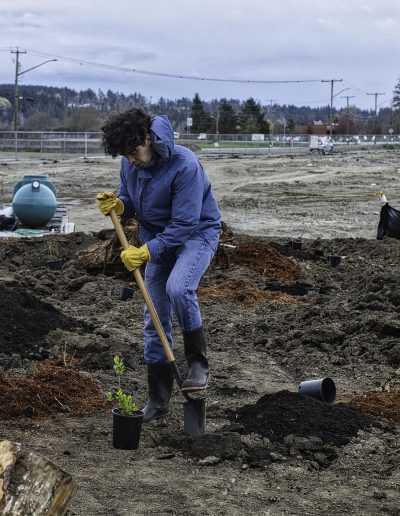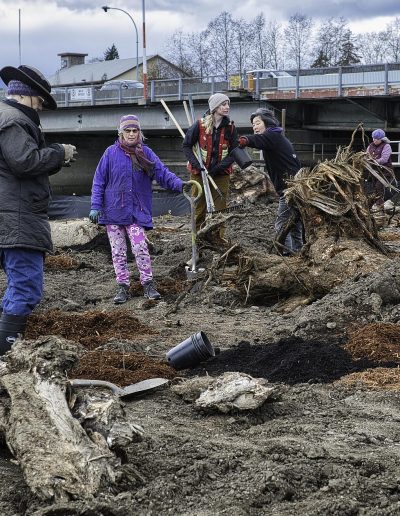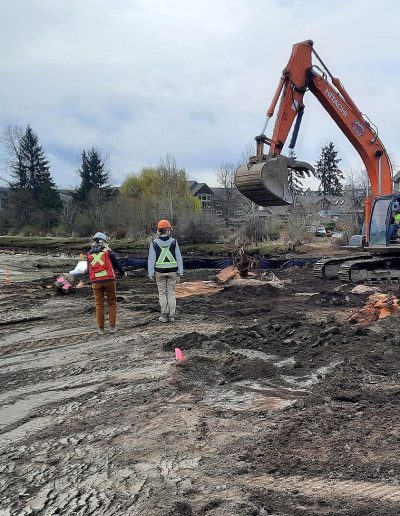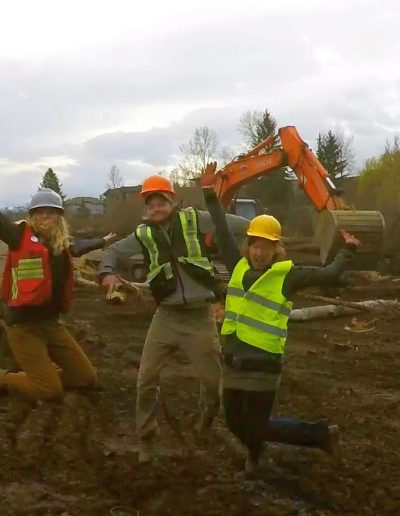First Plants in the Ground at Kus-kus-sum
Drone Footage of Planting ~ Rickskopter
K’omoks First Nation Welcome by Elder Donna Mitchell and Councillor Katherine Frank ~ Graeme Robetson
Planting and watering ~ Caila Holbrook
I wanted to give a big, heart-felt thank you to all the volunteers who came out to help us with our very first planting at Kus-kus-sum. It was a testament to the commitment of this community, and for us at Project Watershed it marked a significant step in restoring and rematriating this important place within our estuary. It was an absolute pleasure to get to connect with so many of you as we work together towards making this project happen. This project has always represented something shared, collective, and collaborative, and last week’s planting was a testament to that. ~ Caitlin Pierzchalski, Executive Director, Project Watershed
With the help of K’ómoks Milestone Joint Venture and 30 Project Watershed volunteers, approximately 400 plants were planted this spring at Kus-kus-sum. After more than six years of planning and fundraising, it was very exciting to put the first plants in the ground.
The plants were a mix of native shrubs and trees that included red flowering currant, Nootka rose, salmonberry, willow, alder and Douglas fir. We want to thank Streamside Native Plants for providing beautiful, healthy native vegetation. These plants will help blend the north end of the site in with the existing vegetation that lines the 17th Street Bridge. Thanks to generous donations by Chinook Forest Products and Grow Tree Care, all the plants have a layer of mulch around them for protection.
We had enormous response to our call for volunteers and filled all volunteer spots within 24 hours. Unfortunately, this meant we had to turn some people away. However, we would like to remind everyone that this was just a teaser. We will be doing much more planting in the fall and will need all the volunteers we can get!
The Kus-kus-sum site is an active work zone. Please DO NOT enter the site without specific permission from Project Watershed staff to do so.
Related Posts
Mallard Creek Restoration Update for 2024
Restoration work in Mallard Creek will continue this year, including invasive removal, restoring connectivity, and trial planting of a new riparian species. Volunteer events starting in September 2024.
Volunteer at Kus-kus-sum Chamber of Commerce Event
We are showing Kus-kus-sum off to businesses in the Valley through a Chamber Business to Business event. We are looking for a few volunteers to assist with this event.
Coastal Plant Monitoring
Get involved with our new vegetation community science monitoring program!
Spring Field Trips
Throughout May and June Project Watershed will be taking elementary school classes out on field trips to learn about estuary and coastal ecology and to assist with planting and plant maintenance.
Working Together to Identify Forage Fish Spawning Beaches
This year marks the 5th year of a partnership between Comox Valley Project Watershed Society and North Island College on a long-term study to examine intertidal spawning habitats of forage fish in the northern Salish Sea.
Glen Urquhart Update – Spring 2024
Latest news from Glen Urquhart restoration progress for spring 2024.












